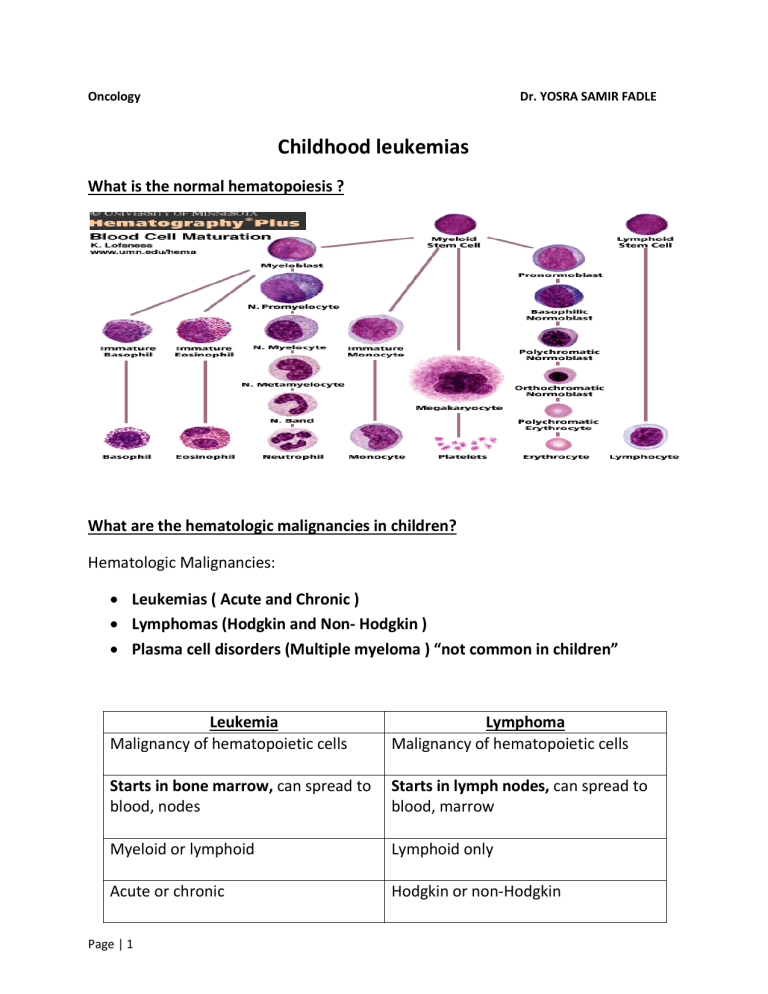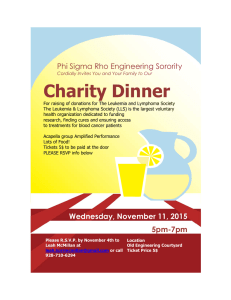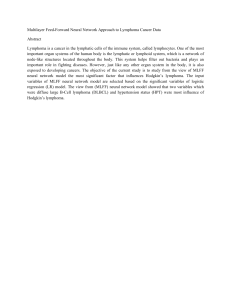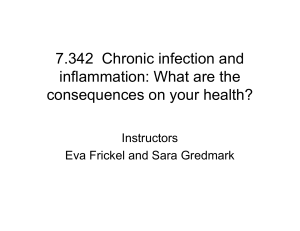
Oncology Dr. YOSRA SAMIR FADLE Childhood leukemias What is the normal hematopoiesis ? What are the hematologic malignancies in children? Hematologic Malignancies: Leukemias ( Acute and Chronic ) Lymphomas (Hodgkin and Non- Hodgkin ) Plasma cell disorders (Multiple myeloma ) “not common in children” Leukemia Malignancy of hematopoietic cells Lymphoma Malignancy of hematopoietic cells Starts in bone marrow, can spread to blood, nodes Starts in lymph nodes, can spread to blood, marrow Myeloid or lymphoid Lymphoid only Acute or chronic Hodgkin or non-Hodgkin Page | 1 Oncology Dr. YOSRA SAMIR FADLE Leukemia Definition:Un-controlled proliferation of hematopoietic lymphoid or myeloid progenitor cells. Causes: Genetic causes. Immune deficiency. Chromosomal abnormality. Exposure to ionizing radiation. Unknown causes. Pathophysiology of Acute Leukemia: Malignant proliferation of immature myeloid or lymphoid cells in the bone marrow Caused by either • Colonal expansion OR Maturation failure . Badness Crowding out of normal cells. Inhibition of normal cell functions. Infiltration of other organs. How is a diagnosis made? Page | 2 Clinical setting Morphology Immunophenotyping Molecular studies Cytogenetics Oncology Dr. YOSRA SAMIR FADLE Clinical setting ( Clinical presentation ) : Pallor, purpura, and fever. Hepatosplenomegaly. LymPhadenopathy. Bone pains and arthralgia due to periosteal infiltration. Fatigue and weight loss. Morphology: Bone marrow aspiration and biopsy: Lymphoblast or myeloblast in acute leukemia> 20% Different stages of myelocyte differentiation in chronic myeloid leukemia Immunophenotyping : Markers of T or B lymphocytes . Markers of myeloblasts. - T-lineage ALL means worse prognosis. - B-lineage ALL means better prognosis. Molecular studies and Cytogenetics Phladilphia chromosome t(9;22) which is common in chronic myeloid leukemia Acute leukemia Sudden onset Can occur in either adults or children Rapidly fatal without treatmen Composed of immature cells (blasts) Page | 3 Chronic leukemia Slow onset Occurs only in adults Longer course Composed of mature cells Oncology Dr. YOSRA SAMIR FADLE Auer rods in acute myeloid leukemia Treatment and Prognosis of ALL Treatment Chemo therapy± bone marrow transplantation. immunotherapy Prognosis Immunophenotype (T is worse) Age (1-10 be er) WBC (>50,000 worse) Cytogenetics (hyperdiploidy better!) Initial response to treatment means (good prognosis) Page | 4 Oncology Dr. YOSRA SAMIR FADLE Pediatric Lymphomas Definition Clonal proliferation of lymphoid elements in LN with occasional BM and tissue and rare blood spread. Lymphoid neoplasms include a diverse group of tumors of: B-cell, T-cell, and NK-cell origin. I-HODGKIN’S Classification of lymphoma II- NON - HODGKIN’S I--HODGKIN’S LYMPHOMA Introduction: Hodgkin lymphoma (formerly called Hodgkin's disease) is a group of malignancies characterized by: Reed-Sternberg cells in an appropriate reactive cellular background consisting of lymphocytes, histiocytes , neutrophils, plasma cells, and fibroblasts. An important clinical feature is : its tendency to arise within lymph node areas. Spread in an orderly fashion to contiguous areas of lymph nodes . Late in the course of the disease, disease vascular invasion leads to widespread haematogenous dissemination. Page | 5 Reed-Sternberg cell Oncology Dr. YOSRA SAMIR FADLE Hodgkin lymphoma has a bimodal age distribution with one peak in the 20s and 30s, and a second peak over the age of 50. Pathological classification of Hodgkin’s lymphoma( Rye Class.) Lymphocyte predominant Nodular sclerosing Mixed cellurarity ( neutrophils , eosinophils and plasma cells )- common Lymphocte depleted Lymphocyte rich Symptoms of Hodgkin's lymphoma: General symptoms: Fever Weight loss Loss of appetite Night sweats Pruritus lethargy Local symptoms: Enlarged, painless, non-tender, superficial lymph nodes Alcohol-induced pain ــــRarely, patients with Hodgkin’s lymphoma complain of severe pain following alcohol ingestion. The pain typically occurs within a few minutes after the ingestion of even a small amount of alcohol in any area involved by the disease. “| The mechanism is unknown.” Symptoms related to the mass: 1. Mediastinal mass: retrosternal chest pain, cough, or shortness of breath. 2. Retroperitoneal lymphadenopathy discomfort and pain in the paravertebral or loin regions, particularly in the supine position. Signs of HL: 1. Lymph node enlargement 2. Cachexia 3. Anemia 4. Splenomegaly 5. Hepatomegaly 6. Jaundice. (Rare) Page | 6 Oncology Dr. YOSRA SAMIR FADLE Staging : I. II. III. IV. Confined to single lymph node region Involvement of two or more nodal areas on the same side of the diaphragm Involvement of nodes on both sides of diaphragm. Spread beyond the lymph nodes e.g. liver or bone marrow. N.B. Each stage is subdivided ed into A and B Ann Arbor Staging System for Hodgkin's and Non Non-Hodgkin's Lymphoma Diagnosis : BLOOD: (FBC, Film, ESR, LFT, LDH, Urate , Ca.) Lymph node excisioal biopsy , image guided needle biopsy. Imaging:-Chest X-ray, ray, CT of thorax, abdominal, pelvis Bone marrow biopsy. Management : Radiotherapy & short course of chemotherapy. prognosis Prognosis of HL Depends on the stage : Page | 7 Oncology Dr. YOSRA SAMIR FADLE II- NON HODGKIN’S LYMPHOMA This is lymphoma without Reed-Sternberg cell. B lymphocyte more than T lymphocyte. The clinical presentation and natural history are more variable than in Hodgkin’s lymphoma. The extra-nodal involvement and leukemic manifestations are common, more than Hodgkin’s lymphoma. Etiology Chromosomal translocations Immunodeficiency either inherited or acquired Infections: - HTLV-1 :(adult T cell lymphoma) - EBV: (Burkitt Lymphoma endemic type, post-transplant lymphoproliferative disease) - (in HIV): B-Cell Lymphomas (unusual site e.g. CNS lymphomas) Hepatitis C infection. Malaria :Burkitt Lymphoma endemic type H. Pylori :(gastric B-Cell lymphomas)(MALT) Celiac disease (gluten sensitive enteropathy ( (T-Cell lymphomas) Classification • There are many classification system for NHL, more recent is the Revised European American Lymphoma Classification ( REAL). • All systems attempt to correlate clinical behavior with histopathology. Page | 8 Oncology Dr. YOSRA SAMIR FADLE Lymphomas may be grouped by how quickly they are likely to grow: Indolent :- (low-grade) lymphomas WHICH grow slowly& cause few symptoms. Aggressive :- (intermediate-grade and high-grade) lymphomas WHICH grow and spread more quickly& cause severe symptoms. N.B : Over time, many indolent lymphomas become aggressive lymphomas. Low grade non Hodgkin's lymphomas Small cell lymphoma. Follicular (it is the most common type of lymphoma). Mantle cell lymphoma. Splenic marginal zone lymphoma. MALT lymphoma. Lymphoplasmacytic NHL. High grade non Hodgkin's lymphomas Diffuse large B cell lymphoma(DLBCL). Diffuse mixed cell lymphoma. Burkitt's lymphoma. Anaplastic large cell lymphoma . Pathogenesis : Clinically: Maturation arrest and proliferation. Due to genetic mutations Either B or T cell Any age, M=F Random LN More tissue infiltration (CNS, GIT, testes,...) General symptoms: ◊ Fever ◊ BLEEDING ◊ Weight loss ◊ Bone pain ◊ Loss of appetite ◊ Adenopathy ◊ Night sweats ◊ Hepatosplenomegally Page | 9 ◊ CNS: headaches, vomiting, nerve palsies Oncology Dr. YOSRA SAMIR FADLE Pathology of NHL More regular LNs. Diffuse or follicular loss of L.N histology No R.S cells Burkitt's lymphoma Is a type of NHL. Common in Africa (EBV infection ).. Pathologically: Starry sky appearance Clinically: children with massive L.N in the jaw. treated with chemotherapy( as B-cell lymphoma) Burkitt's lymphoma Investigations for lymphoma Starry sky appearance Routine CBC, Chemical LN biopsy Cytogenetic studies. o Routine stain. o Immunohistochemistry o FNAC for LN. Molecular biology techniques. Diagnosis : 1. 2. 3. 4. Clinical manifestations . Lymph node excision biopsy , image guided needle biopsy Blood tests. Imaging:-Chest X-ray, CT of thorax, abdominal, pelvis. 5. Bone marrow biopsy. Prognosis: Poor prognostic signs :- Page | 10 Increased age, advanced stage, concomitant disease . T cell lymphoma 5-years survival for treated patients: - 50% for low grade - 30% for high grade




